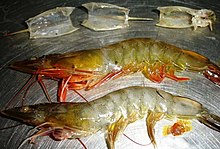Tauras syndrome
The Taura syndrome is a disorder of which decapods are affected. It is triggered by a single-stranded RNA virus , the taurasy syndrome virus (TSV), and is one of the exotic crustacean diseases . In nature, various species of the genus Litopenaeus (Litopenaeus setiferus, Litopenaeus stylirostris and Litopenaeus vannamei ) and the genera Metapenaeus and Palaemon are affected . Other species have been infected experimentally but have shown no symptoms. The virus mostly affects young animals.
The virus was discovered in 1992 in the Taura region of Ecuador .
Course of disease
The course of the disease is usually divided into three phases:
- During the acute phase, the tail fans and the pleopods of the shrimp turn red due to the increased formation of red pigment cells . Necrosis occurs on the edge of the pleopods . These animals are often eaten by seabirds and are therefore part of the TSV distribution vectors . At this stage, mortality can be up to 95%.
- In the transition phase brown-black lesions appear on the cuticle, while the animals mostly behave normally.
- In the chronic phase, the animals show no symptoms apart from a reduced stress resistance.
The incubation period is between 7 and 10 days. The mortality is 40% to over 90%.
Diagnosis
There are numerous ways of diagnosing tauras. Pathologically, symptoms can only be observed in the acute phase and in the transition phase, as described in the course of the disease .
Histological diagnostics are also possible. Here neurotic cells in the cuticular epithelium as well as spherical remnants of the necrotic cells from 1 µm to 20 µm in size and pyknotic and karyorrhectic nuclei would be pathognomonic. The acute stage can be differentiated from the Yellow Head virus by the non-necrotic parenchymal cells of the LO (lymphoid organ) tubules.
The most widespread, however, is diagnosis using RT-PCR . A 231 base pair long sequence is amplified. Since 2009 there are also new primers that lead to a 341 base pair long simplified sequence. Realtime RT-PCR applications also exist.
Taurasy syndrome virus
| Taurasy syndrome virus | ||||||||||||||||
|---|---|---|---|---|---|---|---|---|---|---|---|---|---|---|---|---|
| Systematics | ||||||||||||||||
|
||||||||||||||||
| Taxonomic characteristics | ||||||||||||||||
|
||||||||||||||||
| Scientific name | ||||||||||||||||
| Taura syndrome virus | ||||||||||||||||
| Short name | ||||||||||||||||
| TSV | ||||||||||||||||
| Left | ||||||||||||||||
|
The Taura syndrome virus is a positive-stranded RNA virus of 10205 nucleotides in length and two open reading frames ( English open reading frame , ORF) that 92% of the genome represent. Several species are now known. Type A reacts (e.g. in ELISA ) with the monocolonial antibody Mob 1A1. This is not the case with types B and C. They are differentiated from one another on the basis of their host organisms and their virulence . The TSV particles have a diameter of 32 nm.
The capsid consists mainly of three proteins (55 kDa , 40 kDa , 24 kDa) and a less common protein (58 kDa). Furthermore, the TSV is the first RNA virus in which a BIR domain of an IAP was found. Their function is so far unknown.
Individual evidence
- ↑ a b c Official collection of methods. (PDF) In: Friedrich-Loeffler Institute. April 4, 2014, accessed December 20, 2018 .
- ↑ DIRECTIVE 2006/88 / EC OF THE COUNCIL of October 24, 2006 with health and hygiene regulations for animals in aquaculture and aquaculture products and for the prevention and control of certain aquatic animal diseases. Retrieved December 21, 2018 .
- ↑ Taura Syndrome Virus of Penaeid Shrimp. Retrieved December 21, 2018 .
- ↑ Aquaculture / Fish - DE. Retrieved December 21, 2018 .
- ↑ Jeffrey M. Lotz, Lesber Salazar Anton, M. Andres Soto: Effect of chronic Taura syndrome virus infection on salinity tolerance of Litopenaeus vannamei . In: Diseases of Aquatic Organisms . tape 65 , no. 1 , June 14, 2005, ISSN 0177-5103 , p. 75-78 , doi : 10.3354 / dao065075 , PMID 16042046 .
- ^ Aquatic Animal Diseases Significant to Australia: Identification Field Guide 4th Edition. (PDF) Retrieved December 21, 2018 .
- ↑ a b INFECTION WITH TAURA SYNDROME VIRUS. (PDF) Accessed December 21, 2018 .
- ↑ NUNAN LM, POULOS BT & LIGHTNER DV: Reverse transcription polymerase chain reaction (RT-PCR) used for the detection of Taura Syndrome Virus (TSV) in experimentally infected shrimp . In: Diseases Of Aquatic Organisms . tape 34 , 1998, pp. 87-91 .
- ↑ NAVARRO SA, TANG KFJ & LIGHTNER DV: An improved Taura syndrome virus (TSV) RT-PCR using newly designed primers . In: Aquaculture . tape 293 , 2009, pp. 290-292 .
- ↑ Quantitative assay for measuring the Taura syndrome virus and yellow head virus load in shrimp by real-time RT-PCR using SYBR Green chemistry . In: DHAR AK, ROUX MM & KLIMPEL KR (eds.): Journal of Virological Methods . tape 104 , 2002, pp. 69-82 .
- ↑ ICTV Master Species List 2018b.v2 . MSL # 34, March 2019
- ↑ a b c d ICTV: ICTV Taxonomy history: Enterovirus C , EC 51, Berlin, Germany, July 2019; Email ratification March 2020 (MSL # 35)
- ↑ a b Jocelyne Mari, Bonnie T. Poulos, Donald V. Lightner, Jean-Robert Bonami: Shrimp Taura syndrome virus: genomic characterization and similarity with members of the genus Cricket paralysis-like viruses . In: Journal of General Virology . tape 83 , no. 4 , 2002, p. 915-926 , doi : 10.1099 / 0022-1317-83-4-915 ( microbiologyresearch.org [accessed December 21, 2018]).
